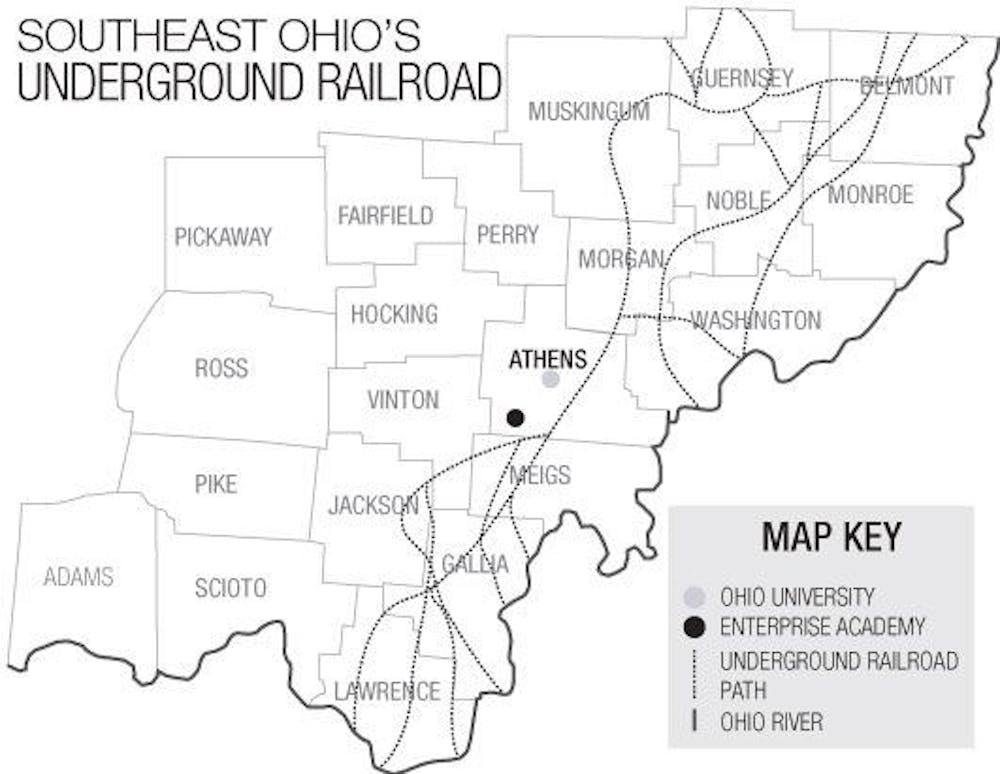Athens was a pivotal stop along the underground railroad
Editors Note: This story was originally posted on Thursday, February 2, 2012
As the sun set in the west, a few brave men in the east would rise with the moon, head down to the Ohio River, and wade the waters in hopes of rescuing slaves from the prejudiced prison on the other side.
The early 1800s brought a divided society into the land that later became Athens. There were the colonists who rejected the idea of human bondage yet refused to shop at the same stores or sit in the same schoolhouses as people of color.
“And then there were the humanitarians,” said Richard Dean, retired hearing, speech and language professor at Ohio University. “The people involved in the Underground Railroad had to be very careful because they were in the midst of others who hated blacks.”
The men who opened their cellars and staircases to shelter runaway slaves from their livid masters were the ones who made it into the history books, taking the first step in battling prejudice in America.
“These people really got involved and risked their lives to help enslaved persons,” said Ada Adams, former vice president of the Ohio Multicultural Genealogical Society and co-author of A Significant Presence: A Pictorial Glimpse of the Black Experience in Athens County, Ohio. “I never call them slaves. They were held against their will and sought freedom. I call them freedom seekers.”
These freedom seekers traveled on foot through murky waters and dense woods for up to 15 miles a night. En route to Canada, promised freedom by the North Star, they made a few notable stops in the neighborhood.
“All along the (Ohio) border were slave states, with the exception of Pennsylvania,” said Nancy Aiken, a board member of the Ohio Multicultural Genealogical Center and fellow author of A Significant Presence. “The New Englanders who lived here were very influential in anti-slavery, and because of that, the people around them were more apt to aid runaways.”
Late Ohio historian Wilbur Siebert estimated that the Underground Railroad covered more than 3,000 miles of the state. Adams, who has spent most of her career researching Southeast Ohio’s involvement in the 19th century abolition movement, has discovered at least 10 safe houses still standing in Athens County, including White’s Mill.
“It was a whole secret operation,” she said. “Slave catchers were still coming into Athens looking for their property, and it speaks highly of the character of people who moved into this area that they protected them.”
When Virginia started subjugating slaves almost two centuries before, the trend exploded in the South. The Northwest Territory — Ohio and Michigan — was a hotspot not just for freedom seekers but also for the whites who supported them.
Their efforts were kept discreet, as the Fugitive Slave Act of 1793 was still in effect, allowing slave catchers to enter even free territory to drag slaves from barns, basements and holes in the wall, reclaiming them as their own.
Though a free state, Ohio advocated for segregated schools. It wasn’t until 1847 that blacks and mulattos — persons of both white and black descent — were allowed to even step foot in a white schoolhouse. Most denied black students, though, to avoid taxation.
But that didn’t stop men such as Robert Wilson, Ohio University’s third president, from bringing blacks to the North. Under Wilson’s presidency, John Newton Templeton became America’s fourth black man to graduate college in 1828.
Born on a South Carolina cotton plantation, Templeton was enslaved until 1813. He came to Ohio under the wing of President Wilson and lived with him in a log cabin on the Hocking River’s edge. That cabin has since been restored and renamed the Silas Bingham House, a treasure in Athens tourism.
During Templeton’s time at OU, schools would hardly allow African-Americans within campus limits, much less educate them. And because Albany’s Atwood Institute and Citizens Academy denied admittance based on race, blacks in the area decided to build their own school.
In 1847, William Lewis brought his family from Oberlin, Ohio, and opened the Lewis Academy to all Albany youths without consideration of sex or race.
“Albany was a free and open atmosphere for blacks, which made it a good place to run away to,” said Ivan Tribe, history professor at the University of Rio Grande and an Underground Railroad researcher who grew up in Albany. “Most of the safe houses were still standing when I was a boy, but there’s hardly anything still standing today that you could even take a picture of.”
In 1850, the U.S. Census showed that the number of African-Americans living in Lee Township was a measly four; a decade later, though, Albany was booming with 174 black residents, making it the hub of Athens County’s Underground Railroad.
Enrollment in the Lewis Academy skyrocketed until it required stock funds from the community to stay afloat. A new three-story dwelling replaced the school, and the $8,000 academy became the Albany Manual Labor University. It reached its peak in 1858 with 302 students, when the number of blacks and whites in Albany was the same.
Just around the corner, Underground Railroad conductor Dr. Chapman Cline would drop off runaways at the cellar of Albany Mayor John Austen Brown’s general store, where they could reportedly hear the voices of their masters stalking them just upstairs.
Though abandoned, the old store still stands at the corner of Washington and West Clinton streets and now hosts a historical marker recognizing its role in the Underground Railroad.
Soon after blacks began migrating to Albany, the United States’ 11 slave states banded together to form the Confederate States of America. Outraged at their escapees and furious at President Abraham Lincoln’s opposition to expanding slavery, the South fought its neighbors in the Civil War.
But the black residents of Albany were fighting for their freedom too. In 1864, Albany’s Board of Trustees opened the Enterprise Academy, which many suspect was the country’s first black-owned and operated school.
On that board was Virginia-born Albany Manual Labor graduate Thomas J. Ferguson, who co-founded the Ohio Colored Teacher’s Association and became the first black man to serve on a jury in Athens.
The two-story brick building was erected on a 20-acre site later used for dormitories and a fruit farm. Enrollment hit 49 students before the final brick was laid.
In its prime, the Enterprise Academy would sometimes have more than 100 students, each paying $3 for a 12-week term — if they could afford it — and an extra $1 per week for housing.
“Many of our people are poor,” the school’s constitution stated, “and nothing can be collected from them in the form of tuition; yet not one has ever been denied admission or instruction.”
Albany’s black population also was peaking at 300 in the 1870s, almost doubling that of the decade before.
Among Enterprise Academy scholars were William H. Holland, former Texas state senator; Edward C. Berry, who later opened Athens’ prosperous Berry Hotel; and Olivia Davidson, who wed civil-rights leader Booker T. Washington in her Athens County home.
But after Ferguson resigned because of illness in 1886, the school was forced to close and its students were left stranded yet again.
Just five years prior, an Albany black man was accused of molesting a white woman. Before taking the stand, he was kidnapped by a lynch mob and publically hanged on Old South Bridge, where the Richland Avenue Bridge is today.
The execution reminded blacks that, although free, they were in the midst of a prejudiced and segregated society. With no opportunities for education or work and the imminent threat of execution lingering in the village, Albany’s black population began to fade away.
“The reason they stayed here so long was because this area was their safety net,” Adams said. “They came to Ohio for safety but soon realized that they weren’t that safe, so they kept moving.”
By 1888, only half the black population remained, as free and enslaved African-Americans headed further north to Canada, leaving Albany with only the memories of its quest for justice.
In the 1930s, years after the Yankees’ Civil War victory, the number of permanent black residents in Albany had dwindled down to nothing and stayed that way for at least 25 years.
“Albany grew prosperous when it had industries,” said Jessica Cyders, curator of the Athens County Historical Society & Museum. “But that slowly faded away in time, and that was the case with a lot of Southeast Ohio’s small towns.“
Southeast Ohio’s role in the Underground Railroad is still being uncovered today. It has been a primary focus for research at the Ohio Genealogical Center for many years, Aiken and Adams said. The center hosts a tour with Athens’ United Campus Ministries every year to exhibit residential safe houses and hideaway caves from Chauncey to Chesterhill.
Yet only a fraction of Ohio’s history in the anti-slavery movement has been revealed. Today, the memories of blacks crossing the river to freedom and the white men who fought for them linger in Athens, waiting to be discovered.






